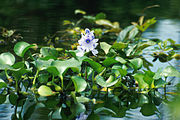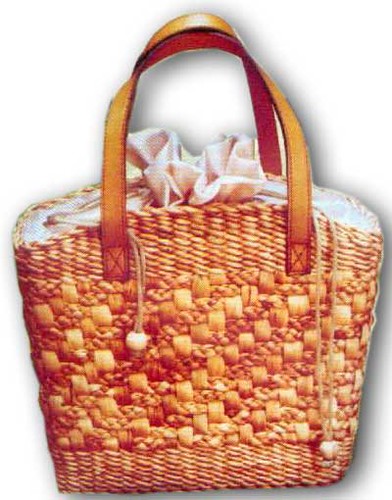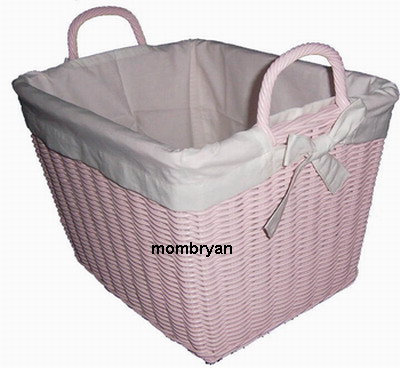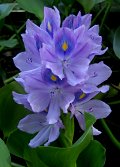The seven species of water hyacinths comprise the genus Eichhornia. Water hyacinth are free-floating perennial aquatic plants native to tropical South America. With broad, thick, glossy, ovate leaves, water hyacinths may rise above the surface of the water as much as 1 meter in height. The leaves are 10-20 cm across, and float above the water surface. They have long, spongy and bulbous stalks. The feathery, freely hanging roots are purplish black. An erect stalk supports a single spike of 8-15 conspicuously attractive flowers, mostly lavender to pinkish in colour with six petals. When not in bloom, water hyacinth may be mistaken for frog's-bit (Limnobium spongia).

One of the fastest growing plants known, water hyacinth reproduces primarily by way of runners or stolons, which eventually form daughter plants. It also produces large quantities of seeds, and these are viable up to thirty years. The common water hyacinth (Eichhornia crassipes) is a vigorous grower known to double its population in two weeks.
Invasiveness as an exotic plant
Water hyacinths have been widely introduced throughout North America, Asia, Australia and Africa. For example, they can be found in large water areas in Louisiana, or in the Kerala Backwaters in India. In many areas they, particularly E. crassipes, are important and pernicious invasive species. First introduced to North America in 1884, an estimated 50 kilograms per square metre of hyacinth once choked Florida's waterways, although the problem there has since been mitigated. When not controlled, water hyacinth will cover lakes and ponds entirely; this dramatically impacts water flow, blocks sunlight from reaching native aquatic plants, and starves the water of oxygen, often leading to fish kills (or turtles). The plants also create a prime habitat for mosquitos, the classic vectors of disease, and a species of snail known to host a parasitic flatworm which causes schistosomiasis (snail fever). Directly blamed for starving subsistence farmers in Papua New Guinea, water hyacinth remains a major problem where effective control programs are not in place. Water Hyacinth are often problematic in man-made ponds if uncontrolled. Water Hyacinth provide a food source for Gold fish when used in Man-made ponds. Water Hyacinth also help to keep water clean in man-made ponds. Water Hyacinth help to provide oxygen to man-made ponds.
Water hyacinth often invades bodies of water that have been impacted by human activities. For example, the plants can unbalance natural lifecycles in artificial reservoirs or in eutrophied lakes that receive large amounts of nutrients.


In some areas, uses are being found for the abundant plants, such as for cattle food and in biogas production. Recently, they have also begun to be used in wastewater treatment due to their fast growth and ability to tolerate high levels of pollution. Parts of the plant are also used in the production of traditional handicrafts in Southeast Asia.

This bag from Water Hyacinths

Beautiful bag from Water Hyacinths

Mebelair dan Handycraft from Water Hyacinths
As chemical and mechanical removal is often too expensive and ineffective, researchers have turned to biological control agents to deal with water hyacinth. The effort began in the 1970s when USDA researchers released three species of weevil known to feed on water hyacinth into the United States, Neochetina bruchi, N. eichhorniae, and the water hyacinth borer Sameodes albiguttalis. Although meeting with limited success, the weevils have since been released in more than 20 other countries. However, the most effective control method remains the control of excessive nutrients and prevention of the spread of this species.
Water hyacinth in Lake Victoria, Africa

Botanists and gardeners carry plants with them in their travels, and experts suspect that this is how the water hyacinth came to West Africa in the 1980s. Its flowers are beautiful; it was probably brought over as an ornamental for garden ponds (United Nations News, 2000). The consensus is that Water Hyacinth entered Lake Victoria from Rwanda via the river Kagera (Ambrose 1997). The exact time and place of introduction has been debated, but the plant is native to South America, and therefore reached Lake Victoria due to human activity. It has spread prolifically, due to lack of natural enemies, an abundance of space, agreeable temperature conditions, and abundant nutrients (Opande et al., 2004). It increased rapidly between 1992-1998, was greatly reduced by 2001, and has since resurged to a lesser degree. Management techniques include (hyacinth-eating) insect controls and manual beach cleanup efforts (Kateregga/Sterner 2007). A water hyacinth infestation is seldom totally eradicated. Instead, it is a situation that must be continually managed (LVEMP, 2004 ) (United Nations News, 2000)).


Water Hyacinth affects the Lake Victorian population in many negative ways. There are economic impacts when the weed blocks boat access. The effects on transportation and fishing are immediately felt. Where the weed is prolific, there is a general increase in several diseases, as the weed creates excellent breeding areas for mosquitoes and other insects. There are increased incidents of skin rash, cough, malaria, encephalitis, bilharzias, gastro intestinal disorders, and schistosomiasis. Water hyacinth also interferes with water treatment, irrigation, and water supply (Opande et al., 2004)). It can smother aquatic life by deoxygenating the water, and it reduces nutrients for young fish in sheltered bays. It has blocked supply intakes for the hydroelectric plant, interrupting electrical power for entire cities. The weed also interrupts local subsistence fishing, blocking access to the beaches (LVEMP, 2004).

Industrial utilization
Since the plant has abundant nitrogen content, it can be used a substrate for biogas production and the sludge obtained from the biogas. However, due to easy accumulation of toxins, the plant is prone to get contaminated when used as feed.
Toxicity
Endogenous
Exogenous
The plant is extremely tolerant towards, and of high capacity of uptaking heavy metals, such as Cd, Cr, Co, Ni, Pb and Hg etc, which could be utilized for the biocleaning of industrial wastewater . Not only the heavy metals, Eichhornia crassipes can also remove toxins, such as cyanide, a process which is environmentally beneficial in areas that have endured gold mining operations .
Eichhornia crassipes
Invasion of Lake Victoria
The plant was introduced by Belgian colonists to Ruanda to beautify their holdings and then advanced by natural means to Lake Victoria where it was first sighted in 1988 There, without any natural enemies, it has become an ecological plague, suffocating the lake, diminishing the fish reservoir, and hurting the local economies. It impedes access to Kisumu and other harbors.
Gallery

| Eichhornia crassipes | ||||||||||||||
|---|---|---|---|---|---|---|---|---|---|---|---|---|---|---|
 | ||||||||||||||
| Scientific classification | ||||||||||||||
| ||||||||||||||
| Binomial name | ||||||||||||||
| Eichhornia crassipes |









No comments:
Post a Comment